Analysis of Business Types and External Factors - BMP3002 Report
VerifiedAdded on 2022/12/09
|12
|2624
|261
Report
AI Summary
This report provides a detailed analysis of various business types, including micro, small, medium, and large businesses, outlining their definitions, characteristics, and examples. It further explores different business structures such as sole traders, partnerships, limited liability businesses, public limited liability businesses, and cooperatives, providing definitions, characteristics, and real-world examples. The report also examines organizational structures, specifically divisional structures, and their impact on business productivity, using Unilever as a case study. Furthermore, it applies PESTLE analysis to identify and explain how political, economic, social, technological, legal, and environmental factors influence the performance of a business, again using Unilever as a reference point. The report concludes with a summary of the key findings and implications for business operations and strategic decision-making.
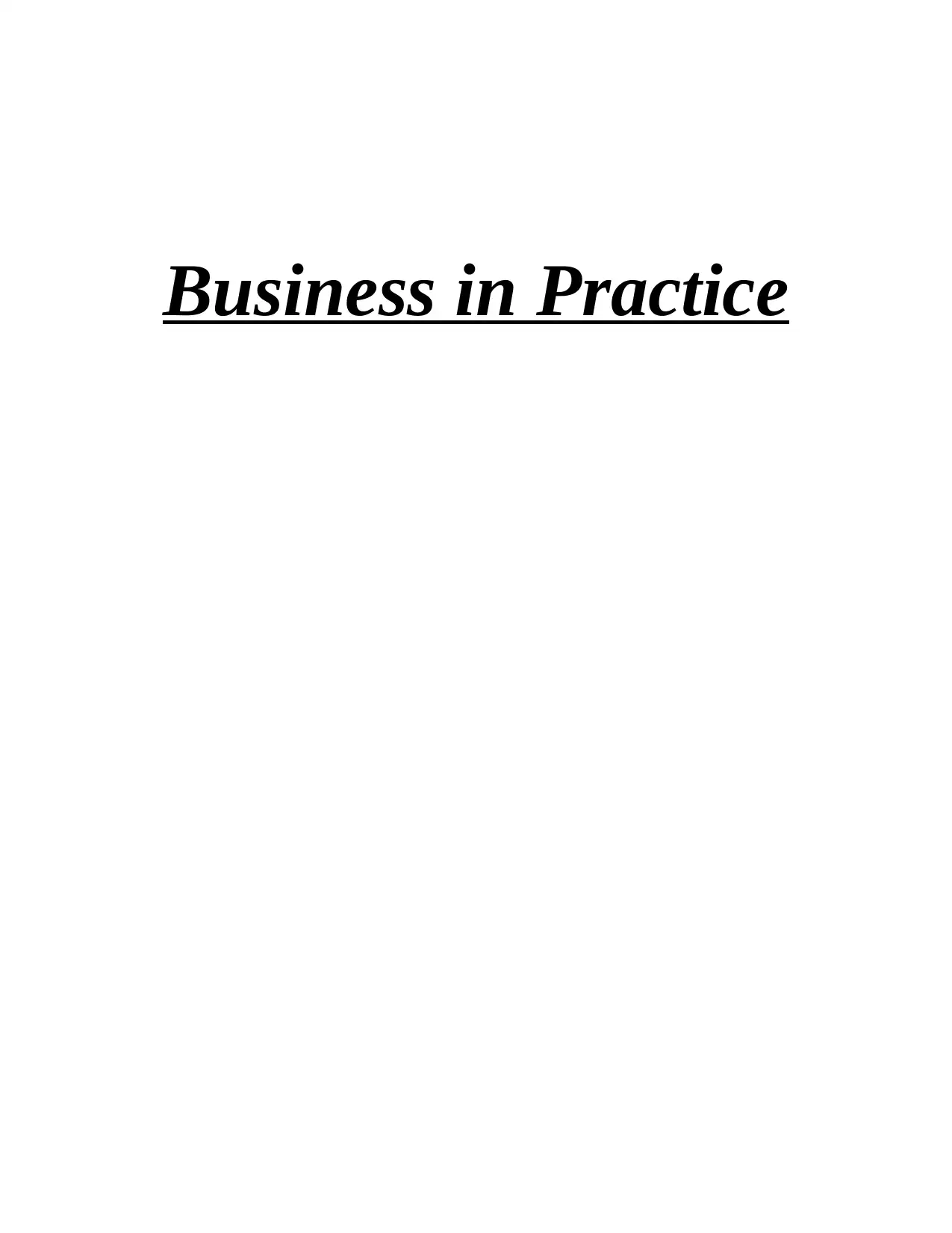
Business in Practice
Paraphrase This Document
Need a fresh take? Get an instant paraphrase of this document with our AI Paraphraser
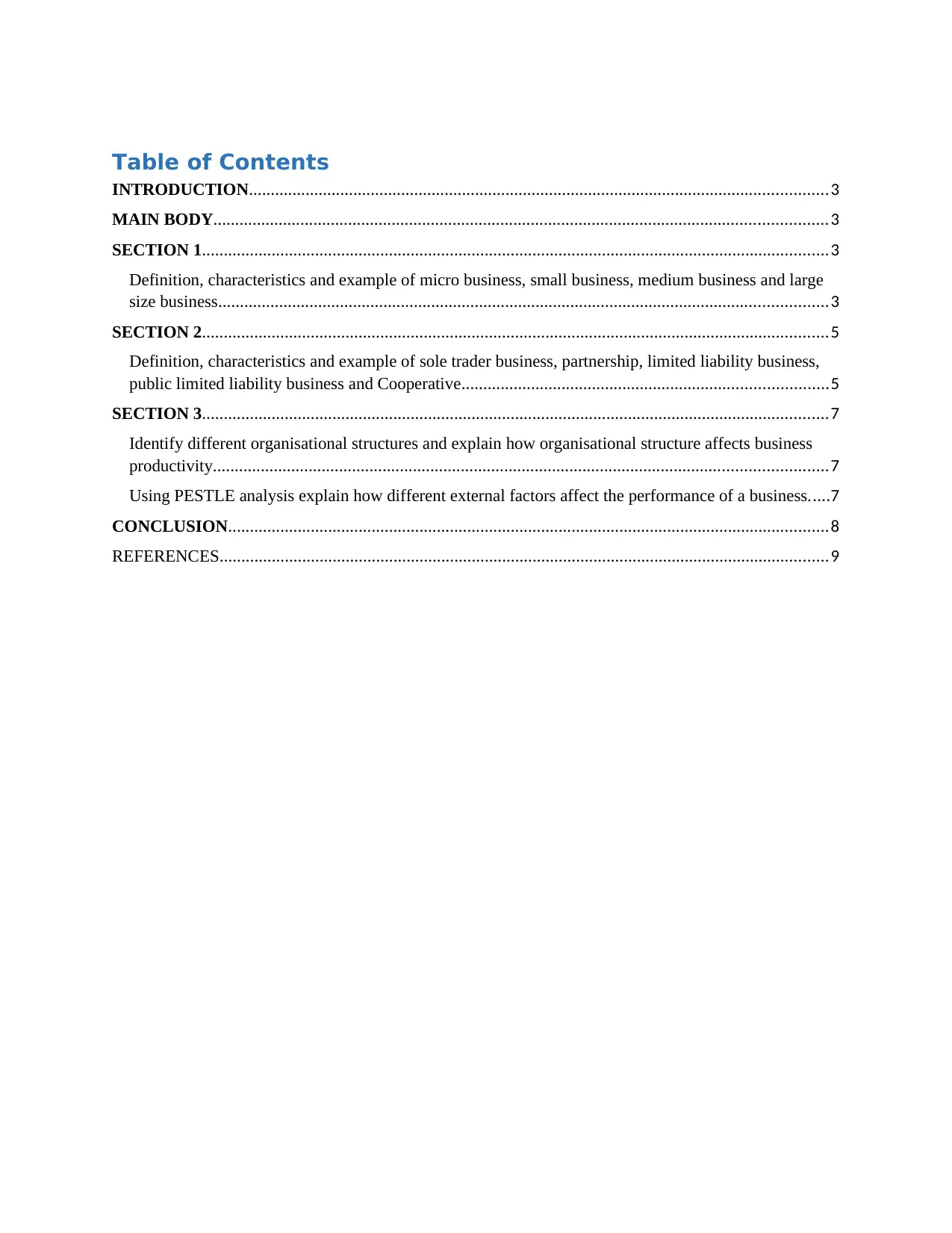
Table of Contents
INTRODUCTION.....................................................................................................................................3
MAIN BODY.............................................................................................................................................3
SECTION 1................................................................................................................................................3
Definition, characteristics and example of micro business, small business, medium business and large
size business............................................................................................................................................3
SECTION 2................................................................................................................................................5
Definition, characteristics and example of sole trader business, partnership, limited liability business,
public limited liability business and Cooperative....................................................................................5
SECTION 3................................................................................................................................................7
Identify different organisational structures and explain how organisational structure affects business
productivity.............................................................................................................................................7
Using PESTLE analysis explain how different external factors affect the performance of a business.....7
CONCLUSION..........................................................................................................................................8
REFERENCES............................................................................................................................................9
INTRODUCTION.....................................................................................................................................3
MAIN BODY.............................................................................................................................................3
SECTION 1................................................................................................................................................3
Definition, characteristics and example of micro business, small business, medium business and large
size business............................................................................................................................................3
SECTION 2................................................................................................................................................5
Definition, characteristics and example of sole trader business, partnership, limited liability business,
public limited liability business and Cooperative....................................................................................5
SECTION 3................................................................................................................................................7
Identify different organisational structures and explain how organisational structure affects business
productivity.............................................................................................................................................7
Using PESTLE analysis explain how different external factors affect the performance of a business.....7
CONCLUSION..........................................................................................................................................8
REFERENCES............................................................................................................................................9

INTRODUCTION
Business refers to the area where they sell goods and services and put efforts in order to
achieve business objectives (Andrews and et.al., 2020). The main objective of this report is to
define, characteristics and example of small, micro, medium, large business. The report also
includes other business such as sole trader, partnership, limited liability, public limited liability
and cooperative business. The report includes Unilever is taken as a base company to identify
external factors which affect their business.
MAIN BODY
SECTION 1
Definition, characteristics and example of micro business, small business, medium business and
large size business Micro business
Definition: Micro business is defined as a business where there is small number of
employees in organisation. In other words, it can be said that there are less than 10 people to
operate a micro business. They are generally the one who take small loan from bank as this type
of business distributes their goods and services in local areas.
Characteristics: Micro business is a business which means that the turnover of £ 632000
and in balance sheet in this type of business there are less than 10 employees in organisation.
Example: The best example of micro business is Boss Brewing as it is founded in the
year 2014 and headquarters in located in Swansea, South wales in United Kingdom. It is owned
by husband and wife named Sarah and Roy Allkin and has been operating as a craft brewery.
Small business
Definition: Small companies are privately managed companies, partnerships, or sole proprietors
with less staff and/or lower annual sales than a larger company or industry. This type of industry
generally put their efforts for economic development (Beckerich, Benoit and Delaplace, 2019).
Characteristics: The main characteristics of small business are that there should be less
than 50 employees in organisation and less than £10 million turnover. This type of
Business refers to the area where they sell goods and services and put efforts in order to
achieve business objectives (Andrews and et.al., 2020). The main objective of this report is to
define, characteristics and example of small, micro, medium, large business. The report also
includes other business such as sole trader, partnership, limited liability, public limited liability
and cooperative business. The report includes Unilever is taken as a base company to identify
external factors which affect their business.
MAIN BODY
SECTION 1
Definition, characteristics and example of micro business, small business, medium business and
large size business Micro business
Definition: Micro business is defined as a business where there is small number of
employees in organisation. In other words, it can be said that there are less than 10 people to
operate a micro business. They are generally the one who take small loan from bank as this type
of business distributes their goods and services in local areas.
Characteristics: Micro business is a business which means that the turnover of £ 632000
and in balance sheet in this type of business there are less than 10 employees in organisation.
Example: The best example of micro business is Boss Brewing as it is founded in the
year 2014 and headquarters in located in Swansea, South wales in United Kingdom. It is owned
by husband and wife named Sarah and Roy Allkin and has been operating as a craft brewery.
Small business
Definition: Small companies are privately managed companies, partnerships, or sole proprietors
with less staff and/or lower annual sales than a larger company or industry. This type of industry
generally put their efforts for economic development (Beckerich, Benoit and Delaplace, 2019).
Characteristics: The main characteristics of small business are that there should be less
than 50 employees in organisation and less than £10 million turnover. This type of
⊘ This is a preview!⊘
Do you want full access?
Subscribe today to unlock all pages.

Trusted by 1+ million students worldwide
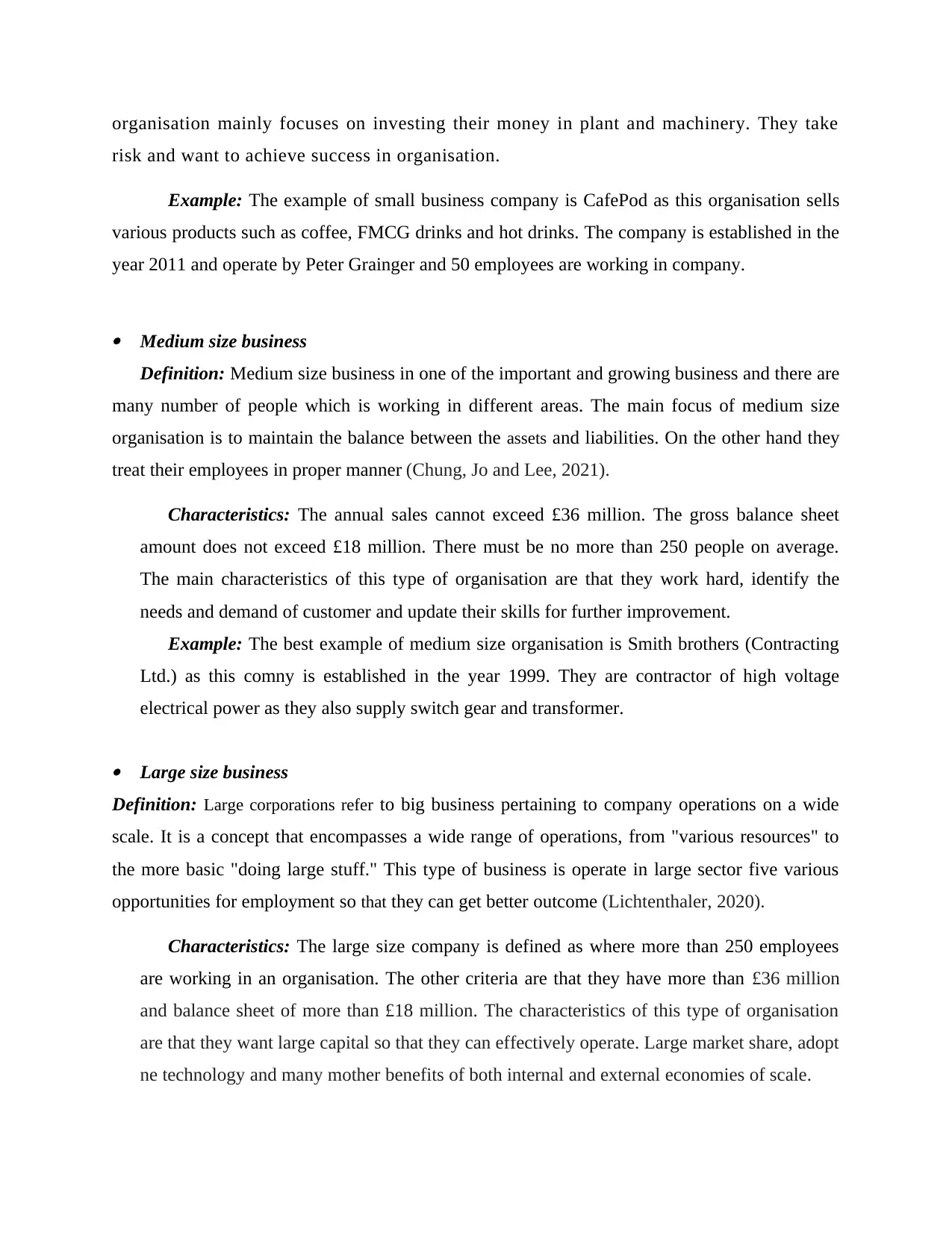
organisation mainly focuses on investing their money in plant and machinery. They take
risk and want to achieve success in organisation.
Example: The example of small business company is CafePod as this organisation sells
various products such as coffee, FMCG drinks and hot drinks. The company is established in the
year 2011 and operate by Peter Grainger and 50 employees are working in company.
Medium size business
Definition: Medium size business in one of the important and growing business and there are
many number of people which is working in different areas. The main focus of medium size
organisation is to maintain the balance between the assets and liabilities. On the other hand they
treat their employees in proper manner (Chung, Jo and Lee, 2021).
Characteristics: The annual sales cannot exceed £36 million. The gross balance sheet
amount does not exceed £18 million. There must be no more than 250 people on average.
The main characteristics of this type of organisation are that they work hard, identify the
needs and demand of customer and update their skills for further improvement.
Example: The best example of medium size organisation is Smith brothers (Contracting
Ltd.) as this comny is established in the year 1999. They are contractor of high voltage
electrical power as they also supply switch gear and transformer.
Large size business
Definition: Large corporations refer to big business pertaining to company operations on a wide
scale. It is a concept that encompasses a wide range of operations, from "various resources" to
the more basic "doing large stuff." This type of business is operate in large sector five various
opportunities for employment so that they can get better outcome (Lichtenthaler, 2020).
Characteristics: The large size company is defined as where more than 250 employees
are working in an organisation. The other criteria are that they have more than £36 million
and balance sheet of more than £18 million. The characteristics of this type of organisation
are that they want large capital so that they can effectively operate. Large market share, adopt
ne technology and many mother benefits of both internal and external economies of scale.
risk and want to achieve success in organisation.
Example: The example of small business company is CafePod as this organisation sells
various products such as coffee, FMCG drinks and hot drinks. The company is established in the
year 2011 and operate by Peter Grainger and 50 employees are working in company.
Medium size business
Definition: Medium size business in one of the important and growing business and there are
many number of people which is working in different areas. The main focus of medium size
organisation is to maintain the balance between the assets and liabilities. On the other hand they
treat their employees in proper manner (Chung, Jo and Lee, 2021).
Characteristics: The annual sales cannot exceed £36 million. The gross balance sheet
amount does not exceed £18 million. There must be no more than 250 people on average.
The main characteristics of this type of organisation are that they work hard, identify the
needs and demand of customer and update their skills for further improvement.
Example: The best example of medium size organisation is Smith brothers (Contracting
Ltd.) as this comny is established in the year 1999. They are contractor of high voltage
electrical power as they also supply switch gear and transformer.
Large size business
Definition: Large corporations refer to big business pertaining to company operations on a wide
scale. It is a concept that encompasses a wide range of operations, from "various resources" to
the more basic "doing large stuff." This type of business is operate in large sector five various
opportunities for employment so that they can get better outcome (Lichtenthaler, 2020).
Characteristics: The large size company is defined as where more than 250 employees
are working in an organisation. The other criteria are that they have more than £36 million
and balance sheet of more than £18 million. The characteristics of this type of organisation
are that they want large capital so that they can effectively operate. Large market share, adopt
ne technology and many mother benefits of both internal and external economies of scale.
Paraphrase This Document
Need a fresh take? Get an instant paraphrase of this document with our AI Paraphraser

Example: The best example of Unilever is that they are operating as a consumer
multinational organisation where they distribute their goods in all countries. They products
include personal, beauty and other products. There are large number of employees is 155000
working in organisation. It is founded in the year 1928 and retains the largest market share in
industry.
SECTION 2
Definition, characteristics and example of sole trader business, partnership, limited liability
business, public limited liability business and Cooperative.
Sole trader business
Definition: The sole trade is the earliest and also most traditional type of business structure. A
sole proprietor, also known as a business owner or ownership, is an unincorporated enterprise
with only single holder who imposes personal tax on the corporation' earnings (Mataveli, Ayala
and Gil, 2020).
Characteristics: There are various characteristics of sole trader which means that they are
operated by single person. So, they are the one who share all profit and loss which lead to make
decision in proper manner. There is another characteristic is that they so not have much legal
formalities and have unlimited liability.
Example: The example of sole trader is Kurt Geiger which is established in the year 1963
and the owner is Kurt Geiger. They sell various types of footwear and other accessories and
their headquarter is located in London and United Kingdom. Partnership
Definition: Collaboration is a legally binding agreement between three or more
individuals to run and maintain a company and share the profits. Partnerships come in a variety
of shapes and sizes. In a relationship company, for example, all partners share obligations and
gains equally.
multinational organisation where they distribute their goods in all countries. They products
include personal, beauty and other products. There are large number of employees is 155000
working in organisation. It is founded in the year 1928 and retains the largest market share in
industry.
SECTION 2
Definition, characteristics and example of sole trader business, partnership, limited liability
business, public limited liability business and Cooperative.
Sole trader business
Definition: The sole trade is the earliest and also most traditional type of business structure. A
sole proprietor, also known as a business owner or ownership, is an unincorporated enterprise
with only single holder who imposes personal tax on the corporation' earnings (Mataveli, Ayala
and Gil, 2020).
Characteristics: There are various characteristics of sole trader which means that they are
operated by single person. So, they are the one who share all profit and loss which lead to make
decision in proper manner. There is another characteristic is that they so not have much legal
formalities and have unlimited liability.
Example: The example of sole trader is Kurt Geiger which is established in the year 1963
and the owner is Kurt Geiger. They sell various types of footwear and other accessories and
their headquarter is located in London and United Kingdom. Partnership
Definition: Collaboration is a legally binding agreement between three or more
individuals to run and maintain a company and share the profits. Partnerships come in a variety
of shapes and sizes. In a relationship company, for example, all partners share obligations and
gains equally.

Characteristics: The characteristics of partnership is that they have to contact with their
partners legally and mention that either they will share equal or in an agreed ratio. The any
partner cannot transfer their interest to another person.
Example: The example of partnership is Uber and Spotify as they have contact with each
other to achieve the same goal but they sell different products and services in market. Uber
passengers can select from a Spotify playlist to listen to during their journey. This makes it
easier for Spotify and Uber users to enjoy their rides in the taxi. Limited liability business
Definition: The term "limited liability" applies to the fact that lenders are really only responsible
for their portion of the transaction. For example, if a shareholder spends 20% of the company’s
earnings, they are only liable for that 20% of the company’s earnings, plus any liabilities
(Medrano, Cornejo-Cañamares and Olarte-Pascual, 2020). This is the most common form of limited
company in the United Kingdom.
Characteristics: There are various characteristics such as they have rights under the law
distinct from its owners. They have the advantage of excluding their members' responsibility.
The characteristics are that they are treated as a partnership for tax purposes. They have the
versatility of a relationship in terms of organisation.
Example: The example of limited liability is John Lewis Partnership who sells various
goods and services which include clothing, gifts, food and other services. There are 83,000
employees working and headquarter is located at United kingdom, London. Public limited liability business
Definition: A Public Limited Company (PLC) is a distinct legal corporate body that
allows the public to sell its securities on a stock exchange. The use of the PLC abbreviation after
a company's name is needed, as it informs customers and those concerned with the firm that it is
a publicly listed stock.
Characteristics: There are various characteristics such as there is minimum paid up share
capital. The feature is perpetual succession, legal rules and regulation and many other features.
They require at least 90% of the amount of share capital.
Example: The best example of public limited company is Astra Zeneca PLC WHICH IS
British Swedish multinational biotechnology and pharmaceutical. The headquarter is located
partners legally and mention that either they will share equal or in an agreed ratio. The any
partner cannot transfer their interest to another person.
Example: The example of partnership is Uber and Spotify as they have contact with each
other to achieve the same goal but they sell different products and services in market. Uber
passengers can select from a Spotify playlist to listen to during their journey. This makes it
easier for Spotify and Uber users to enjoy their rides in the taxi. Limited liability business
Definition: The term "limited liability" applies to the fact that lenders are really only responsible
for their portion of the transaction. For example, if a shareholder spends 20% of the company’s
earnings, they are only liable for that 20% of the company’s earnings, plus any liabilities
(Medrano, Cornejo-Cañamares and Olarte-Pascual, 2020). This is the most common form of limited
company in the United Kingdom.
Characteristics: There are various characteristics such as they have rights under the law
distinct from its owners. They have the advantage of excluding their members' responsibility.
The characteristics are that they are treated as a partnership for tax purposes. They have the
versatility of a relationship in terms of organisation.
Example: The example of limited liability is John Lewis Partnership who sells various
goods and services which include clothing, gifts, food and other services. There are 83,000
employees working and headquarter is located at United kingdom, London. Public limited liability business
Definition: A Public Limited Company (PLC) is a distinct legal corporate body that
allows the public to sell its securities on a stock exchange. The use of the PLC abbreviation after
a company's name is needed, as it informs customers and those concerned with the firm that it is
a publicly listed stock.
Characteristics: There are various characteristics such as there is minimum paid up share
capital. The feature is perpetual succession, legal rules and regulation and many other features.
They require at least 90% of the amount of share capital.
Example: The best example of public limited company is Astra Zeneca PLC WHICH IS
British Swedish multinational biotechnology and pharmaceutical. The headquarter is located
⊘ This is a preview!⊘
Do you want full access?
Subscribe today to unlock all pages.

Trusted by 1+ million students worldwide
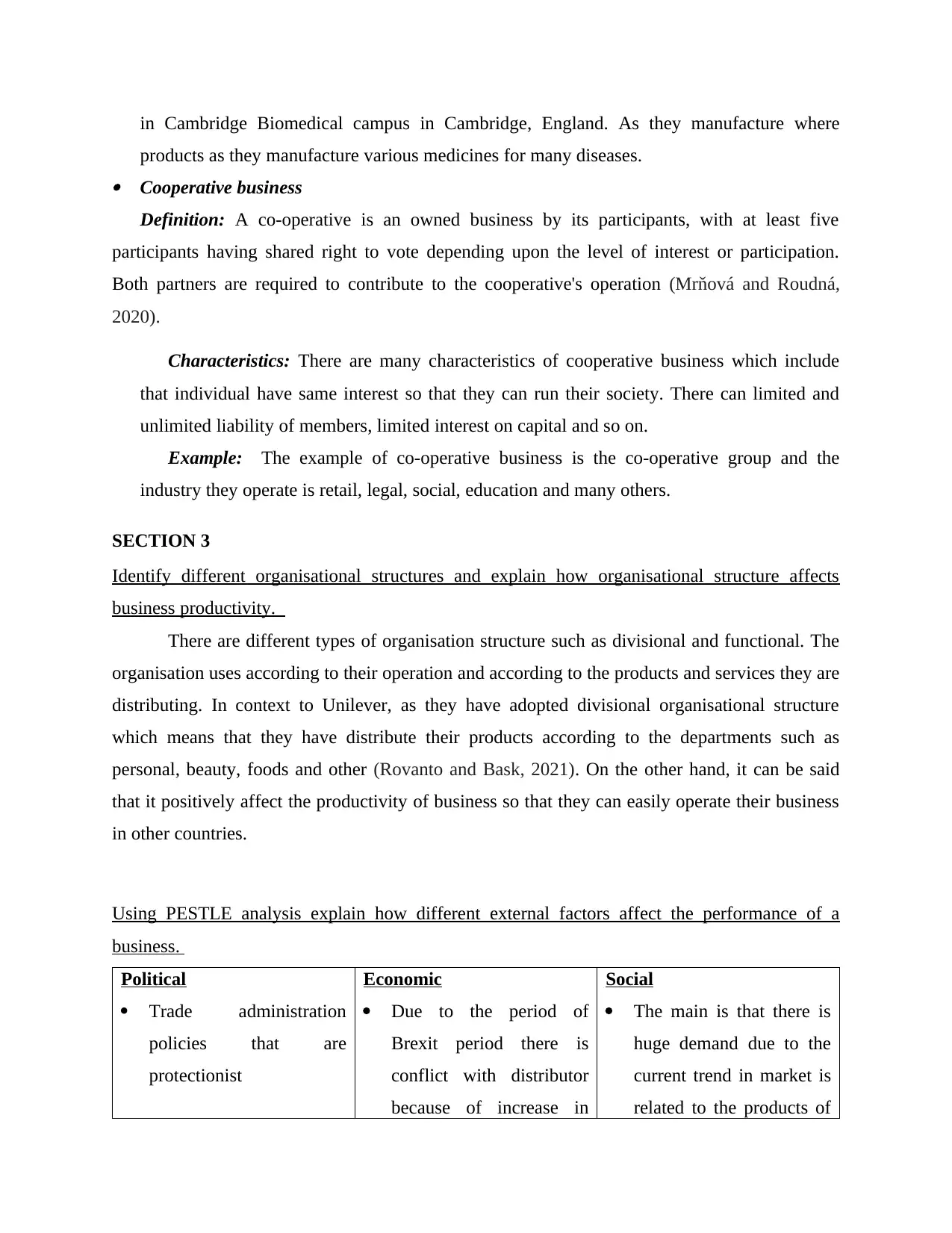
in Cambridge Biomedical campus in Cambridge, England. As they manufacture where
products as they manufacture various medicines for many diseases. Cooperative business
Definition: A co-operative is an owned business by its participants, with at least five
participants having shared right to vote depending upon the level of interest or participation.
Both partners are required to contribute to the cooperative's operation (Mrňová and Roudná,
2020).
Characteristics: There are many characteristics of cooperative business which include
that individual have same interest so that they can run their society. There can limited and
unlimited liability of members, limited interest on capital and so on.
Example: The example of co-operative business is the co-operative group and the
industry they operate is retail, legal, social, education and many others.
SECTION 3
Identify different organisational structures and explain how organisational structure affects
business productivity.
There are different types of organisation structure such as divisional and functional. The
organisation uses according to their operation and according to the products and services they are
distributing. In context to Unilever, as they have adopted divisional organisational structure
which means that they have distribute their products according to the departments such as
personal, beauty, foods and other (Rovanto and Bask, 2021). On the other hand, it can be said
that it positively affect the productivity of business so that they can easily operate their business
in other countries.
Using PESTLE analysis explain how different external factors affect the performance of a
business.
Political
Trade administration
policies that are
protectionist
Economic
Due to the period of
Brexit period there is
conflict with distributor
because of increase in
Social
The main is that there is
huge demand due to the
current trend in market is
related to the products of
products as they manufacture various medicines for many diseases. Cooperative business
Definition: A co-operative is an owned business by its participants, with at least five
participants having shared right to vote depending upon the level of interest or participation.
Both partners are required to contribute to the cooperative's operation (Mrňová and Roudná,
2020).
Characteristics: There are many characteristics of cooperative business which include
that individual have same interest so that they can run their society. There can limited and
unlimited liability of members, limited interest on capital and so on.
Example: The example of co-operative business is the co-operative group and the
industry they operate is retail, legal, social, education and many others.
SECTION 3
Identify different organisational structures and explain how organisational structure affects
business productivity.
There are different types of organisation structure such as divisional and functional. The
organisation uses according to their operation and according to the products and services they are
distributing. In context to Unilever, as they have adopted divisional organisational structure
which means that they have distribute their products according to the departments such as
personal, beauty, foods and other (Rovanto and Bask, 2021). On the other hand, it can be said
that it positively affect the productivity of business so that they can easily operate their business
in other countries.
Using PESTLE analysis explain how different external factors affect the performance of a
business.
Political
Trade administration
policies that are
protectionist
Economic
Due to the period of
Brexit period there is
conflict with distributor
because of increase in
Social
The main is that there is
huge demand due to the
current trend in market is
related to the products of
Paraphrase This Document
Need a fresh take? Get an instant paraphrase of this document with our AI Paraphraser
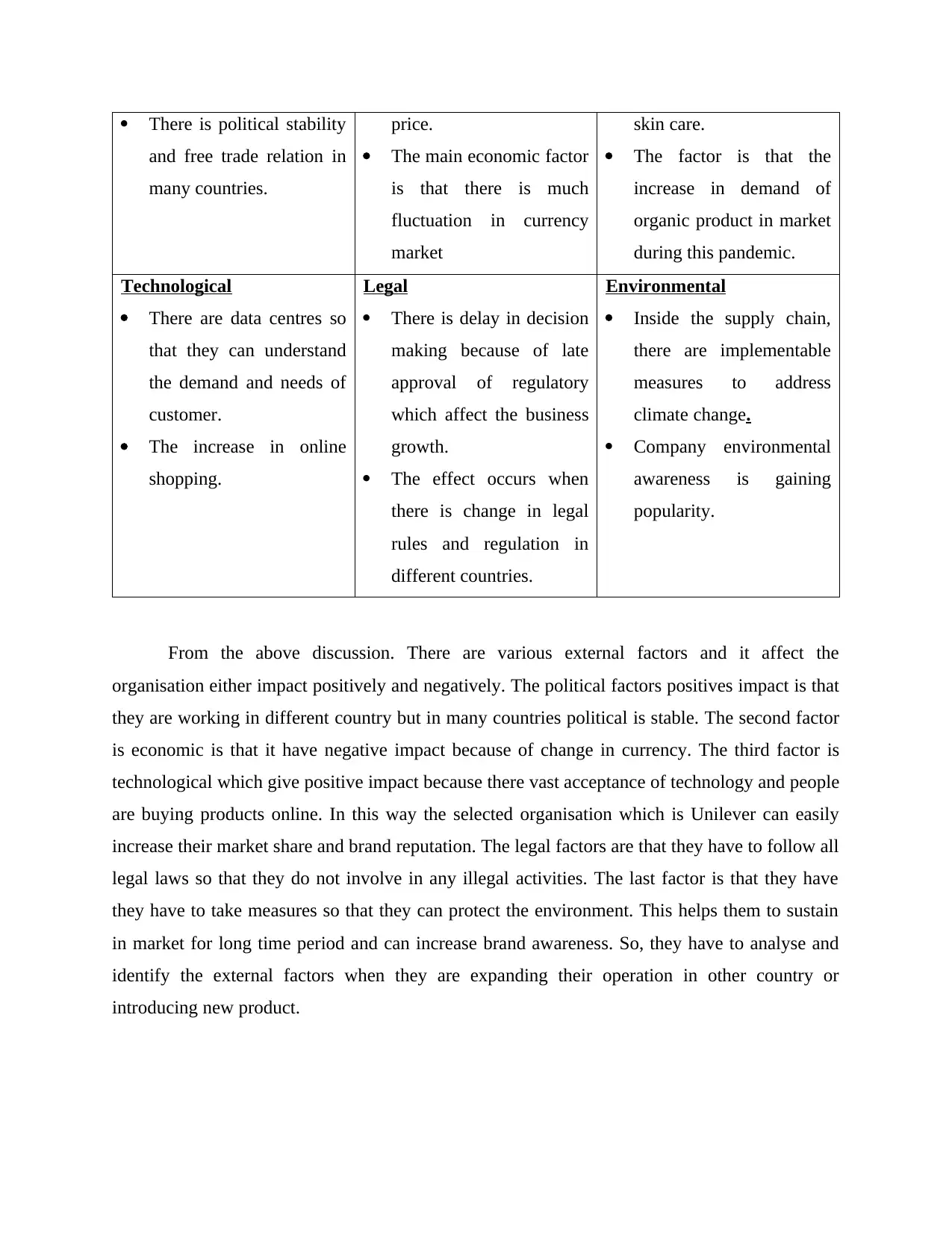
There is political stability
and free trade relation in
many countries.
price.
The main economic factor
is that there is much
fluctuation in currency
market
skin care.
The factor is that the
increase in demand of
organic product in market
during this pandemic.
Technological
There are data centres so
that they can understand
the demand and needs of
customer.
The increase in online
shopping.
Legal
There is delay in decision
making because of late
approval of regulatory
which affect the business
growth.
The effect occurs when
there is change in legal
rules and regulation in
different countries.
Environmental
Inside the supply chain,
there are implementable
measures to address
climate change.
Company environmental
awareness is gaining
popularity.
From the above discussion. There are various external factors and it affect the
organisation either impact positively and negatively. The political factors positives impact is that
they are working in different country but in many countries political is stable. The second factor
is economic is that it have negative impact because of change in currency. The third factor is
technological which give positive impact because there vast acceptance of technology and people
are buying products online. In this way the selected organisation which is Unilever can easily
increase their market share and brand reputation. The legal factors are that they have to follow all
legal laws so that they do not involve in any illegal activities. The last factor is that they have
they have to take measures so that they can protect the environment. This helps them to sustain
in market for long time period and can increase brand awareness. So, they have to analyse and
identify the external factors when they are expanding their operation in other country or
introducing new product.
and free trade relation in
many countries.
price.
The main economic factor
is that there is much
fluctuation in currency
market
skin care.
The factor is that the
increase in demand of
organic product in market
during this pandemic.
Technological
There are data centres so
that they can understand
the demand and needs of
customer.
The increase in online
shopping.
Legal
There is delay in decision
making because of late
approval of regulatory
which affect the business
growth.
The effect occurs when
there is change in legal
rules and regulation in
different countries.
Environmental
Inside the supply chain,
there are implementable
measures to address
climate change.
Company environmental
awareness is gaining
popularity.
From the above discussion. There are various external factors and it affect the
organisation either impact positively and negatively. The political factors positives impact is that
they are working in different country but in many countries political is stable. The second factor
is economic is that it have negative impact because of change in currency. The third factor is
technological which give positive impact because there vast acceptance of technology and people
are buying products online. In this way the selected organisation which is Unilever can easily
increase their market share and brand reputation. The legal factors are that they have to follow all
legal laws so that they do not involve in any illegal activities. The last factor is that they have
they have to take measures so that they can protect the environment. This helps them to sustain
in market for long time period and can increase brand awareness. So, they have to analyse and
identify the external factors when they are expanding their operation in other country or
introducing new product.

CONCLUSION
From the above discussion, it is analysed that there are different types of business and
they operate their business in various countries. The different types of business such as micro,
small, medium and large. On the other hand, there are some other types which include public
limited, cooperative, partnership and so on. There is organisation structure which is functional
and divisional. There are some external factors that include political, economic, social,
technological, legal and environmental.
From the above discussion, it is analysed that there are different types of business and
they operate their business in various countries. The different types of business such as micro,
small, medium and large. On the other hand, there are some other types which include public
limited, cooperative, partnership and so on. There is organisation structure which is functional
and divisional. There are some external factors that include political, economic, social,
technological, legal and environmental.
⊘ This is a preview!⊘
Do you want full access?
Subscribe today to unlock all pages.

Trusted by 1+ million students worldwide

REFERENCES
Books and Journal
Andrews, R. and et.al., 2020. Corporatization in the public sector: explaining the growth of local
government companies. Public Administration Review. 80(3). pp.482-493.
Beckerich, C., Benoit, S. and Delaplace, M., 2019. Are the reasons for companies to locate
around central versus peripheral high-speed rail stations different? The cases of Reims
central station and Champagne-Ardenne station. European Planning Studies. 27(3).
pp.574-594.
Chung, W. Y., Jo, Y. and Lee, D., 2021. Where should ICT startup companies be established?
Efficiency comparison between cluster types. Telematics and Informatics. 56. p.101482.
Lichtenthaler, U., 2020. Beyond artificial intelligence: why companies need to go the extra
step. Journal of Business Strategy.
Mataveli, M., Ayala, J. C. and Gil, A. J., 2020. An analysis of factors that influence the decision
to export: perspective of Brazilian companies. Academia Revista Latinoamericana de
Administración.
Medrano, N., Cornejo-Cañamares, M. and Olarte-Pascual, C., 2020. The impact of marketing
innovation on companies’ environmental orientation. Journal of Business & Industrial
Marketing.
Mrňová, Z. and Roudná, V., 2020. FORMS OF FACILITY MANAGEMENT PROVISION IN
DIFFERENT TYPES OF COMPANIES. International Multidisciplinary Scientific
GeoConference: SGEM. 20(6.2). pp.193-200.
Rovanto, I. K. and Bask, A., 2021. Systemic circular business model application at the company,
supply chain and society levels—A view into circular economy native and adopter
companies. Business Strategy and the Environment. 30(2). pp.1153-1173.
Books and Journal
Andrews, R. and et.al., 2020. Corporatization in the public sector: explaining the growth of local
government companies. Public Administration Review. 80(3). pp.482-493.
Beckerich, C., Benoit, S. and Delaplace, M., 2019. Are the reasons for companies to locate
around central versus peripheral high-speed rail stations different? The cases of Reims
central station and Champagne-Ardenne station. European Planning Studies. 27(3).
pp.574-594.
Chung, W. Y., Jo, Y. and Lee, D., 2021. Where should ICT startup companies be established?
Efficiency comparison between cluster types. Telematics and Informatics. 56. p.101482.
Lichtenthaler, U., 2020. Beyond artificial intelligence: why companies need to go the extra
step. Journal of Business Strategy.
Mataveli, M., Ayala, J. C. and Gil, A. J., 2020. An analysis of factors that influence the decision
to export: perspective of Brazilian companies. Academia Revista Latinoamericana de
Administración.
Medrano, N., Cornejo-Cañamares, M. and Olarte-Pascual, C., 2020. The impact of marketing
innovation on companies’ environmental orientation. Journal of Business & Industrial
Marketing.
Mrňová, Z. and Roudná, V., 2020. FORMS OF FACILITY MANAGEMENT PROVISION IN
DIFFERENT TYPES OF COMPANIES. International Multidisciplinary Scientific
GeoConference: SGEM. 20(6.2). pp.193-200.
Rovanto, I. K. and Bask, A., 2021. Systemic circular business model application at the company,
supply chain and society levels—A view into circular economy native and adopter
companies. Business Strategy and the Environment. 30(2). pp.1153-1173.
Paraphrase This Document
Need a fresh take? Get an instant paraphrase of this document with our AI Paraphraser


⊘ This is a preview!⊘
Do you want full access?
Subscribe today to unlock all pages.

Trusted by 1+ million students worldwide
1 out of 12
Related Documents
Your All-in-One AI-Powered Toolkit for Academic Success.
+13062052269
info@desklib.com
Available 24*7 on WhatsApp / Email
![[object Object]](/_next/static/media/star-bottom.7253800d.svg)
Unlock your academic potential
Copyright © 2020–2025 A2Z Services. All Rights Reserved. Developed and managed by ZUCOL.





